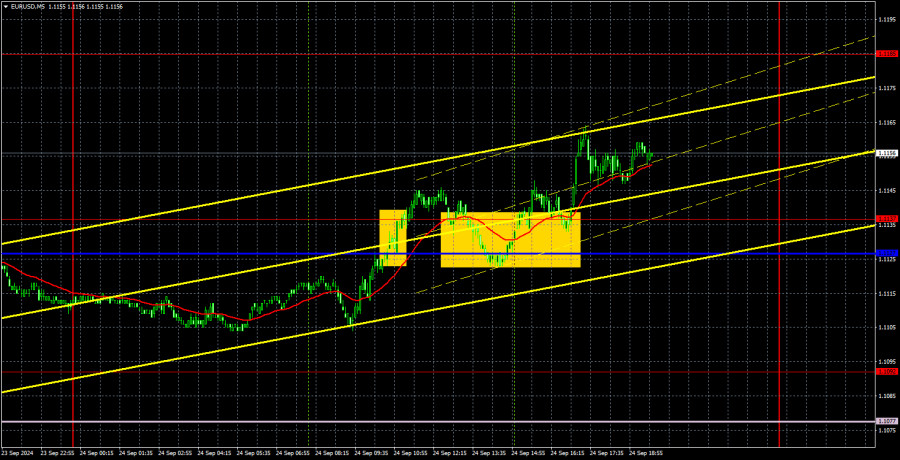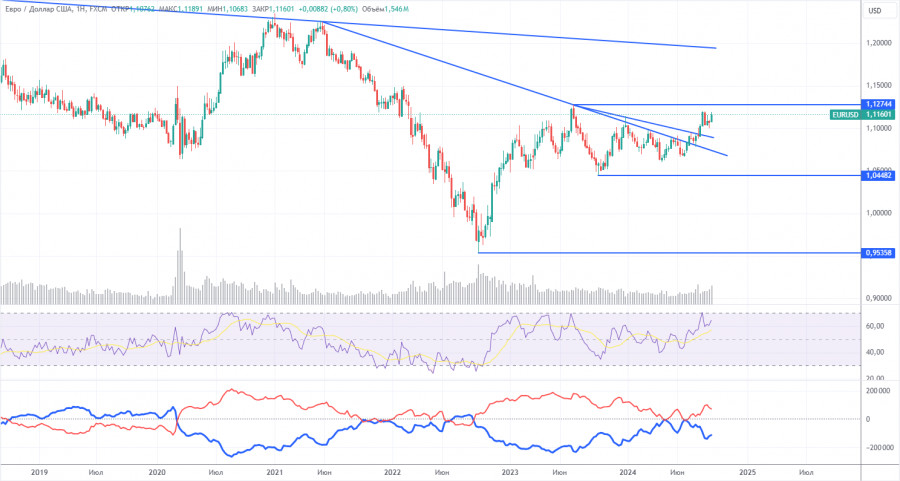Analysis of EUR/USD 5M

The EUR/USD pair continued its upward movement on Tuesday. As the illustration above shows, the price bounced off the Senkou Span B line, which is very important. Thus, the upward trend has been preserved, but in the hourly time frame, it's also clear that the price has been trading in a horizontal channel between the levels of 1.1092 and 1.1185 for over a week. Since the latest bounce occurred from the lower boundary, we can expect movement towards the upper boundary. The euro doesn't even need macroeconomic reports to continue growing. Of course, the euro is rising more modestly than the British pound, but it still grows even when there are no grounds for it. On Tuesday, no important report was published in the Eurozone or the United States.
Therefore, the technical picture remains entirely unchanged. A bounce from the 1.1185 level could also occur, keeping the price within the horizontal channel for a bit longer. However, this doesn't change the essence of the matter. The euro is still hovering around its local highs and shows no intention of moving downward. The EUR/USD pair is one of the most stable, so abrupt changes are uncommon. Like GBP/USD, it cannot sharply rise. Nevertheless, growth continues across all time frames.
Among trading signals, we can note only the breakout of the 1.1127–1.1137 area, followed by a bounce from the top. Here, traders could have opened long positions. By evening, the price had moved up about 20 pips and will likely continue towards the 1.1185 level. Therefore, it's advisable to set the Stop Loss to break even and set Take Profit at the 1.1185 level.
COT report:

The latest COT report is dated September 17. The illustration above clearly shows that the net position of non-commercial traders has remained bullish for a long time. The bears' attempt to gain dominance ended in complete failure. The net position of non-commercial traders (red line) declined in the second half of 2023 and early 2024, while commercial traders (blue line) increased. Currently, professional players are again increasing their long positions.
We also still do not see any fundamental factors supporting the strengthening of the euro. Technical analysis indicates that the price is in a consolidation phase—in other words, a flat trend. In the weekly time frame, it is clear that since December 2022, the pair has been trading between levels 1.0448 and 1.1274. In other words, we have moved from a seven-month flat into an 18-month one.
The red and blue lines are moving further apart, indicating that long positions on the euro have increased. However, such changes cannot be a basis for long-term conclusions within a flat trend. During the last reporting week, the number of long positions in the non-commercial group decreased by 10,500, while the number of short positions increased by 1,200. Accordingly, the net position decreased by 11,700. The euro still has the potential to fall.
Analysis of EUR/USD 1H

In the hourly time frame, the pair has a real chance to end the unfounded upward trend, but these chances continue to diminish before our eyes. The price is flat for now, but the more global upward trend is likely to resume. There's no point in discussing the fundamental and macroeconomic reasons for a new decline in the dollar – there aren't any. To be precise, the market only focuses on the news that suggests selling the dollar. Corrections occur occasionally but do not change the fact that the euro continues to rise without a solid foundation.
For September 25, we highlight the following trading levels: 1.0658–1.0669, 1.0757, 1.0797, 1.0843, 1.0889, 1.0935, 1.1006, 1.1092, 1.1147, 1.1185, 1.1234, 1.1274, as well as the Senkou Span B (1.1096) and Kijun-sen (1.1129) lines. The Ichimoku indicator lines can move during the day, so this should be considered when identifying trading signals. Remember to set a Stop Loss to break even if the price has moved in the intended direction by 15 pips. This will protect you against potential losses if the signal turns out to be false.
On Tuesday, macroeconomic and fundamental factors will be absent in both the Eurozone and the United States. There is a report on new home sales in the US, but it's insignificant, and we don't expect any reaction. Currently, the pair is trading in a horizontal channel, so the boundary levels of this channel are of particular importance.
Explanation of Illustrations:
Support and resistance levels: Thick red lines near which the trend may end. They are not sources of trading signals.
Kijun-sen and Senkou Span B lines: These Ichimoku indicator lines, transferred from the 4-hour timeframe to the hourly chart, are strong lines.
Extreme levels: Thin red lines from which the price previously bounced. These provide trading signals.
Yellow lines: Trend lines, trend channels, and other technical patterns.
Indicator 1 on COT charts: The net position size for each category of traders.
The material has been provided by InstaForex Company - www.instaforex.com #














 Download NOW!
Download NOW!
No comments:
Post a Comment